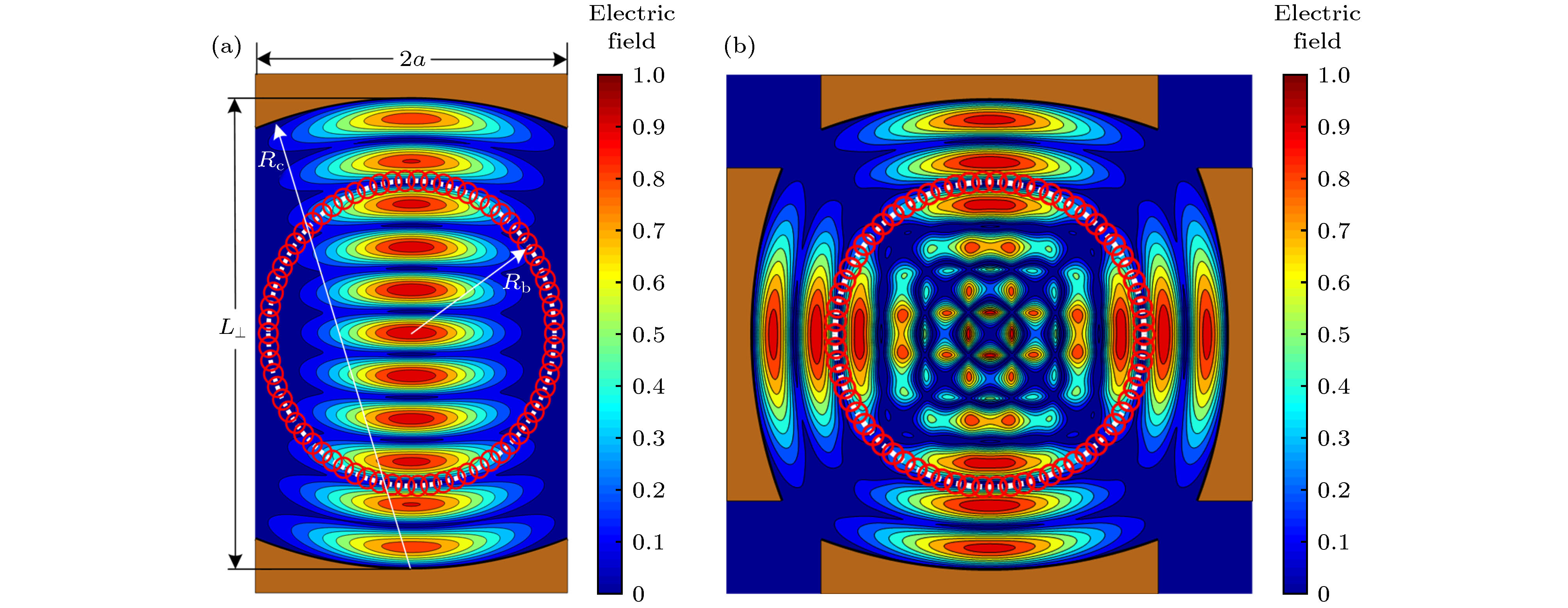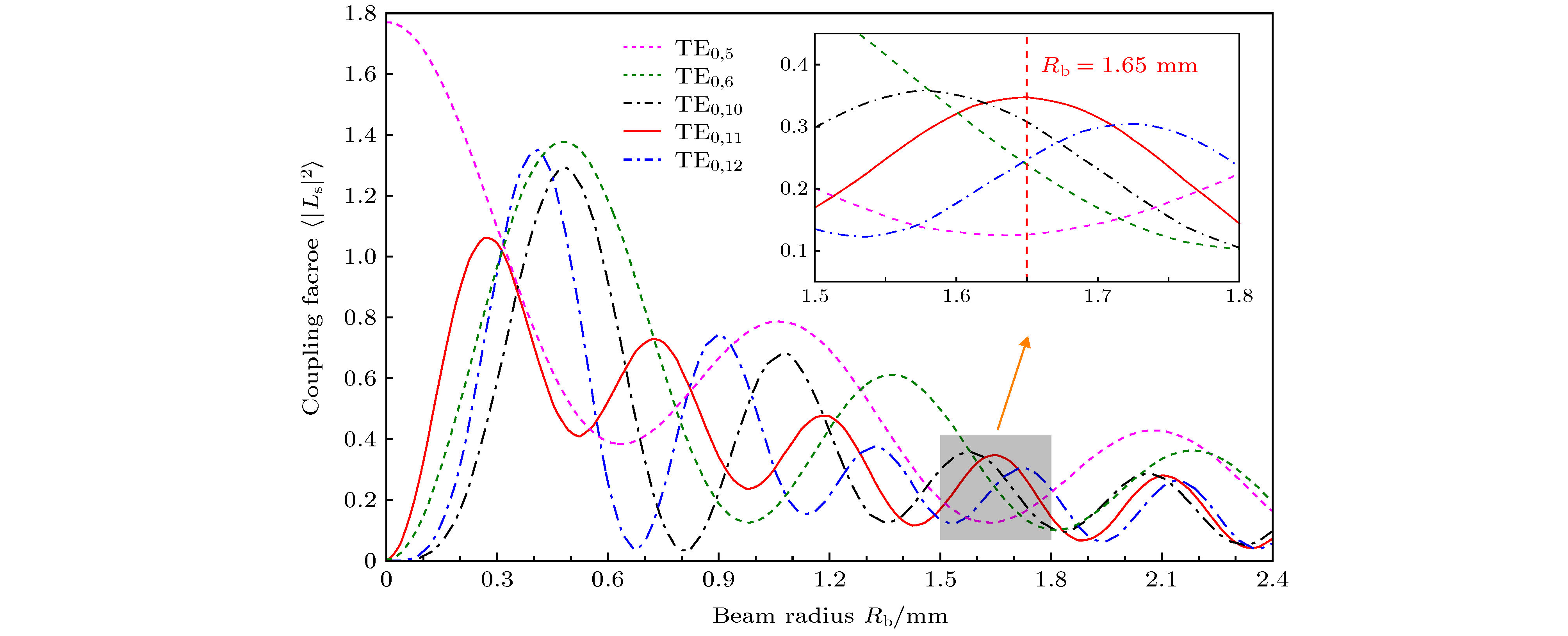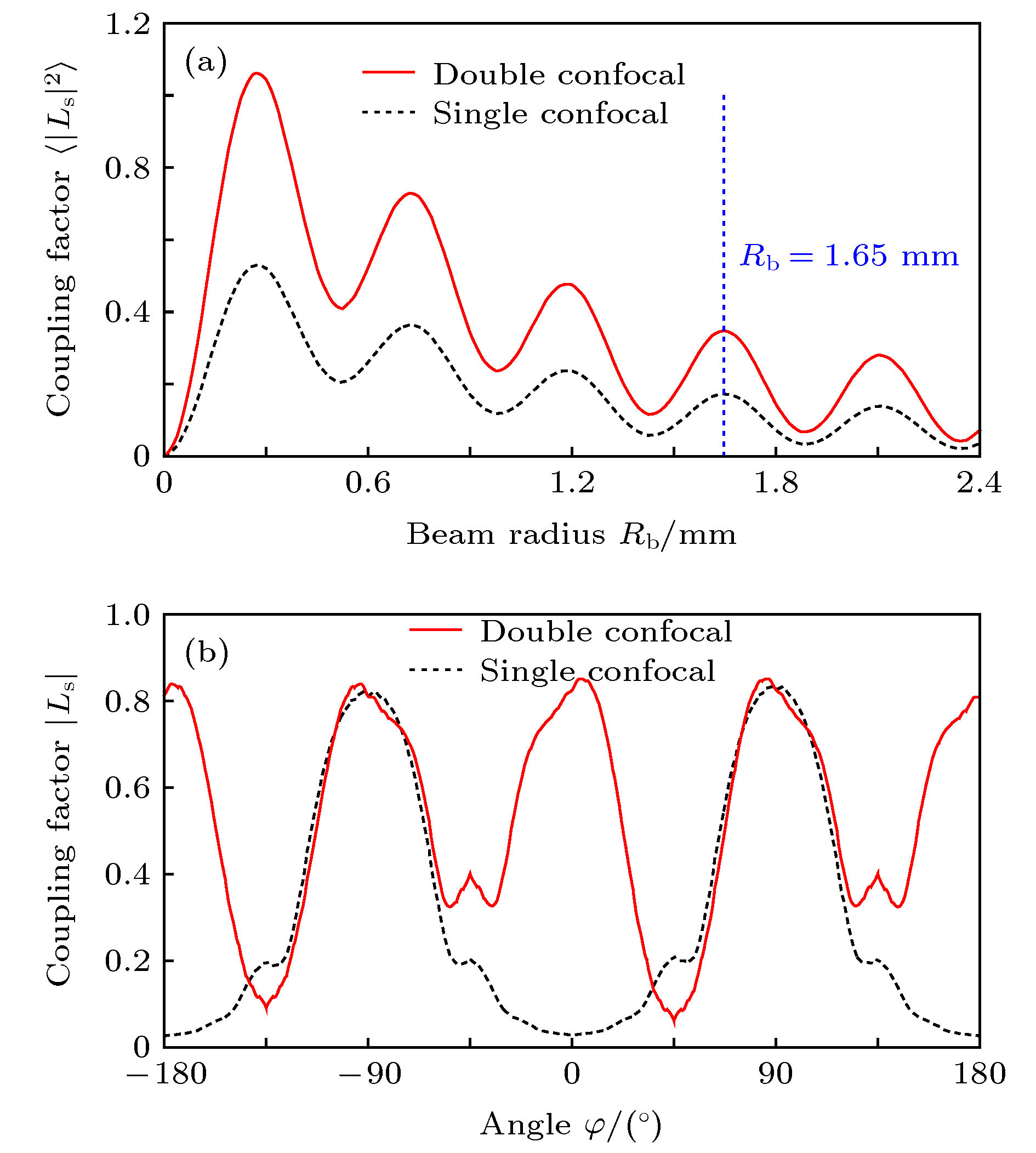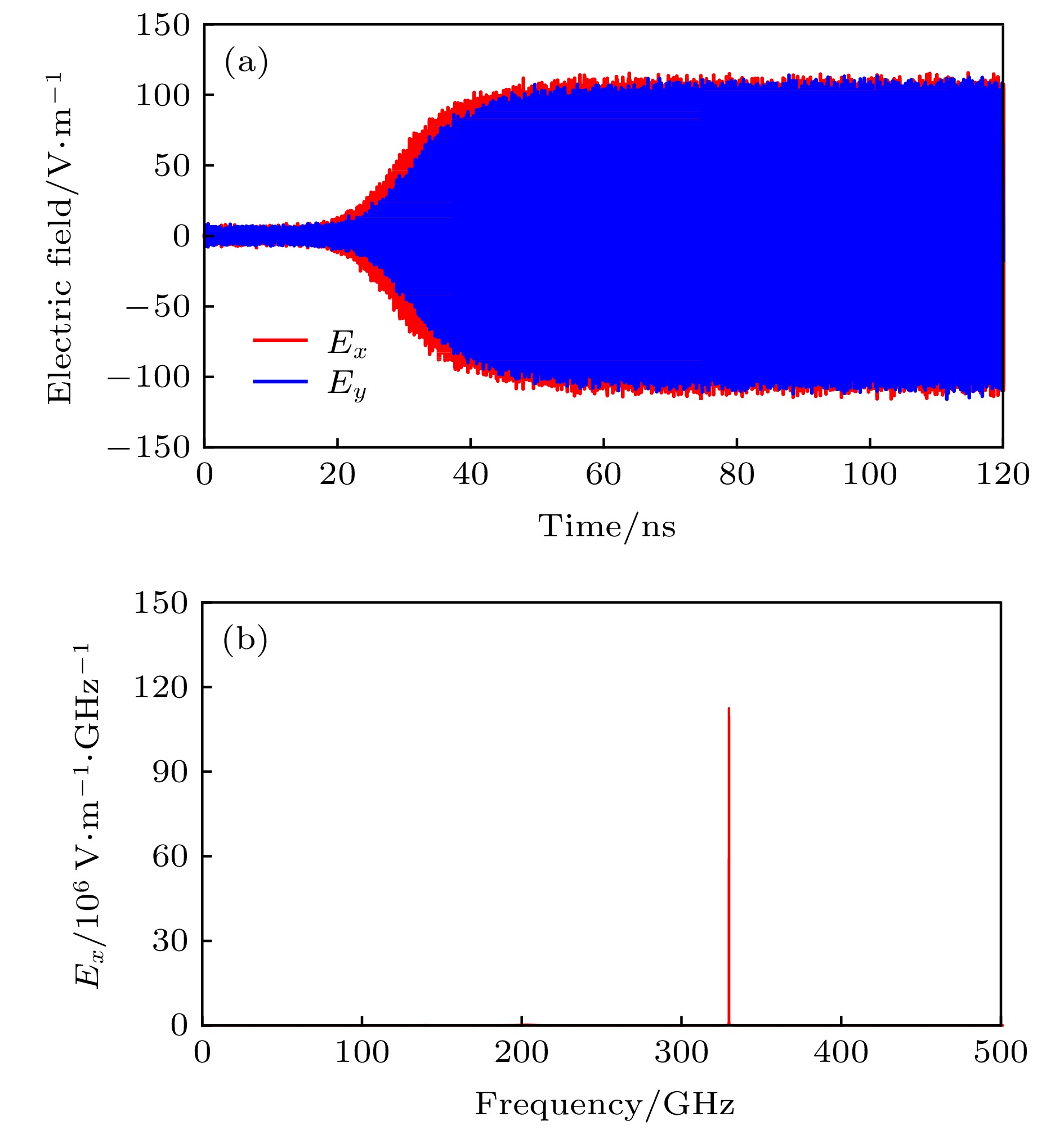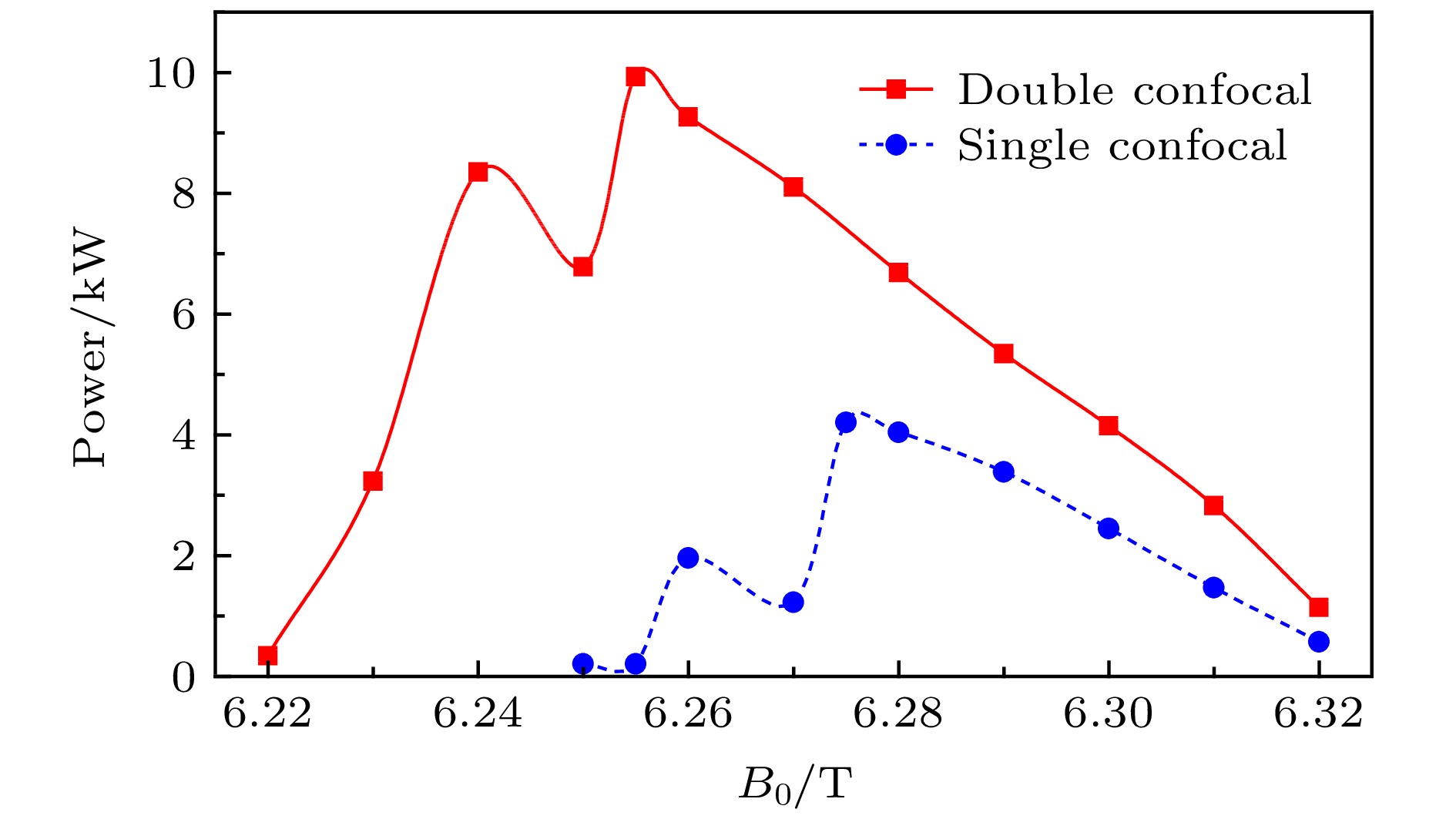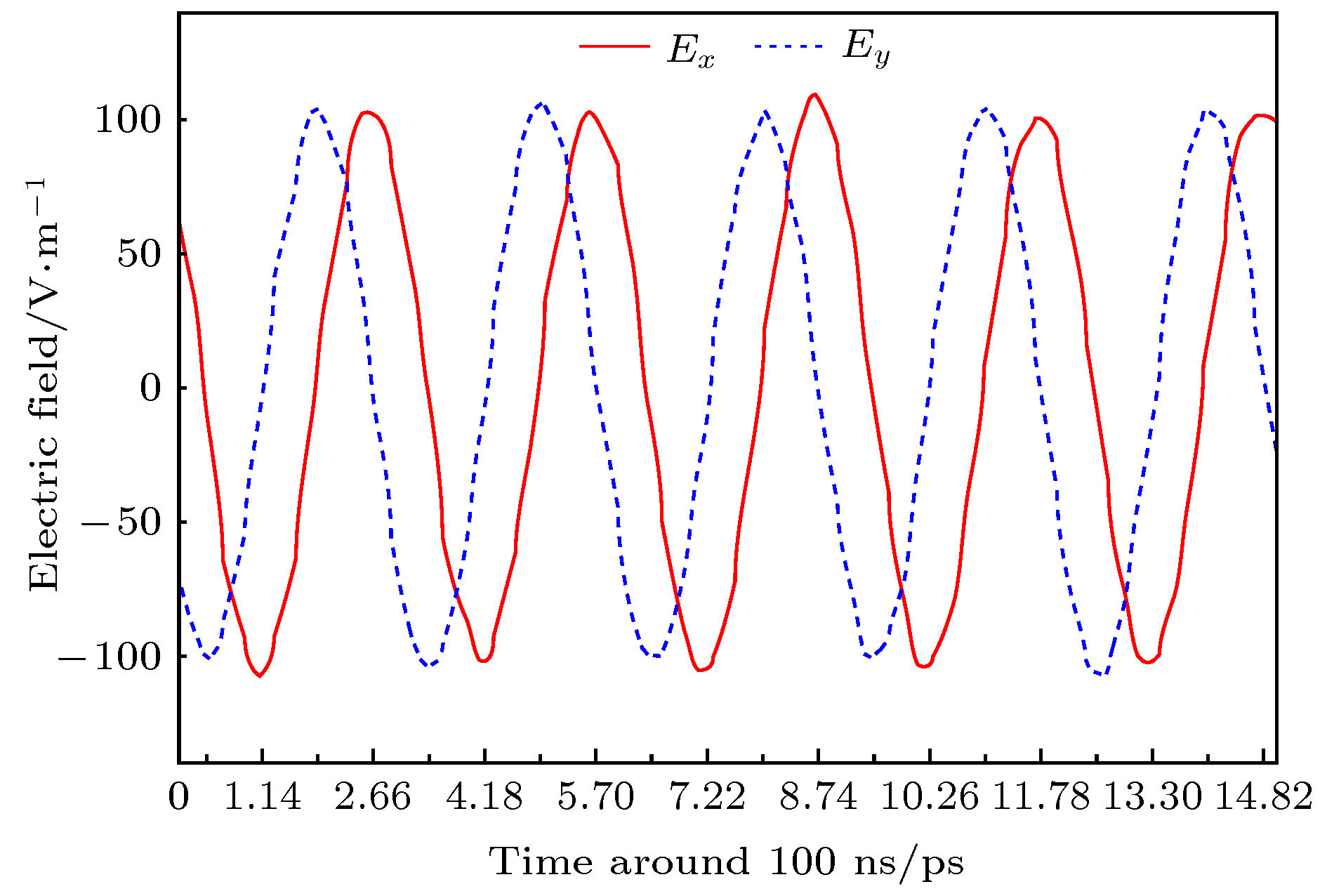-
准光共焦波导具有功率容量大、模式密度低的特点, 能够有效地减少模式竞争对回旋管互作用的影响, 有利于高次谐波太赫兹回旋管的设计. 为提高太赫兹准光回旋管的互作用效率, 在共焦柱面波导的基础上, 研究了一种新型高频互作用结构—双共焦波导结构, 设计了一种330 GHz二次谐波双共焦结构回旋管谐振腔并对其进行了理论分析和粒子模拟. 研究结果表明, 双共焦谐振腔中的高阶模式能够与高次电子回旋谐波发生稳定的相互作用, 并且没有模式竞争现象, 具备工作在太赫兹波段的潜力. 相比普通共焦波导谐振腔, 双共焦谐振腔能够增强准光回旋管的注波互作用强度, 提高回旋管的输出功率和工作效率. 此外, 结果还表明双共焦波导中的电磁波模式是一种由两个独立的共焦波导模式叠加而成的混合模式. 利用这种混合模式有望实现太赫兹回旋管的单注双频工作, 为新型太赫兹辐射源的研究提供了新的途径.Quasi-optical confocal cylindrical waveguide possesses a lot of good characteristics, such as big power capacity and low mode density, which can suppress the mode competition in beam-wave interaction. So quasi-optical waveguide has a great advantage in designing high harmonic terahertz gyrotrons. For the reason that part of electron beams located in a region of weak field intensity play a limited role in beam-wave interactions, the beam-wave interaction is not efficient in confocal cavity. Motivated by enhancing the beam-wave interaction efficiency of quasi-optical gyrotron, we propose a novel terahertz harmonic gyrotron cavity with double confocal waveguide in this paper. The transverse field distribution and the mode spectrum in double confocal waveguide are analyzed and presented. A 330 GHz second harmonic gyrotron with double confocal cavity is designed, theoretically analyzed and simulated by using a particle-in-cell (PIC) code. The results obtained for double confocal cavity are compared with the results for single confocal cavity, and the physical mechanism of beam-wave interaction enhancement in double confocal cavity is discussed. Theoretical results show that the double confocal cavity is able to increase the coupling strength of beam-wave interaction, thus, to improve the output power and the interaction efficiency of quasi-optical gyrotron. The PIC simulation results suggest that a high-order waveguide mode in double confocal cavity can steadily interact with the high harmonic cyclotron mode of electron beam without mode competition. Driven by a 40 kV, 2 A electron beam with a guiding center radius of 1.65 mm and velocity ratio equal to 1.5, output power of 9.9 kW at 328.93 GHz can be generated in the designed double confocal cavity. The beam-wave interaction efficiency increases from 5.3% in single confocal cavity to 12.4% in dual confocal cavity under the same operation parameters. The double confocal cavity has great potential applications in terahertz band. Moreover, this study indicates that the eigen mode in double confocal waveguide is a kind of hybrid mode superimposed by two independent single confocal waveguide modes. This mode characteristic will be beneficial to designing a multifrequency gyrotron oscillator operated in two modes and two cyclotron harmonics, simultaneously, with a single electron beam used, which provides a new possibility to develop the novel terahertz radiation source.
-
Keywords:
- terahertz gyrotron /
- high harmonic /
- quasi-optical cavity /
- double confocal waveguide
[1] Chu K R 2004 Rev. Mod. Phys. 76 489
 Google Scholar
Google Scholar
[2] [3] Thumm M, Denisov G G, Sakamoto K, Tran M Q 2019 Nucl. Fusion 59 073001
 Google Scholar
Google Scholar
[4] Nusinovich G S, Thumm M, Petelin M I 2014 J. Infrared Millimeter Terahertz Waves 35 325
 Google Scholar
Google Scholar
[5] Kariya T, Minami R, Okada M, et al. 2019 Nucl. Fusion 59 066009
 Google Scholar
Google Scholar
[6] Fu W J, Guan X T, Chen C, Li X Y, Yuan X S, Yan Y 2014 IEEE Trans. Electron Dev. 61 2531
 Google Scholar
Google Scholar
[7] Idehara T, Sabchevski S P 2017 J. Infrared Millimeter Terahertz Waves 38 62
 Google Scholar
Google Scholar
[8] Tsvetkov A I, Fokin A P, Sedov A S 2019 J. Infrared Millimeter Terahertz Waves 40 696
 Google Scholar
Google Scholar
[9] Kumar N, Singh U, Bera A, Sinha A K 2016 Infrared Phys. Technol. 76 38
 Google Scholar
Google Scholar
[10] 袁学松, 鄢扬, 傅文杰, 刘頔威 2012 红外与毫米波学报 31 342
 Google Scholar
Google Scholar
Yuan X S, Yan Y, Fu W J, Liu D W 2012 J. Infrared Millim. Waves 31 342
 Google Scholar
Google Scholar
[11] 黄丽萍, 洪斌斌, 刘畅, 唐昌建 2014 物理学报 63 118401
 Google Scholar
Google Scholar
Huang L P, Hong B B, Liu C, Tang C J 2014 Acta Phys. Sin. 63 118401
 Google Scholar
Google Scholar
[12] Sirigiri J R, Shapiro M A, Temkin R J 2003 Phys. Rev. Lett. 90 258302
 Google Scholar
Google Scholar
[13] Ginzburg N S, Zotova I V, Sergeev A S, Zaslavsky V Y, Zheleznov I V 2012 Phys. Rev. Lett. 108 105101
 Google Scholar
Google Scholar
[14] Nanni E A, Lewis S M, Shapiro M A, Griffin R G, Temkin R J 2013 Phys. Rev. Lett. 111 235101
 Google Scholar
Google Scholar
[15] Hu W, Shapiro M, Kriescher K E, Temkin R J 1998 IEEE Trans. Plasma Sci. 26 366
 Google Scholar
Google Scholar
[16] Joye C D, Shapiro M, Sirigiri J R, Temkin R J 2009 IEEE Trans. Electron Dev. 56 818
 Google Scholar
Google Scholar
[17] Guan X T, Fu W J, Yan Y 2017 J. Infrared Millimeter Terahertz Waves 38 1457
 Google Scholar
Google Scholar
[18] Yao Y L, Wang J X, Li H, Tian Q Z, Dong K, Fu H, Lou Y 2017 IEEE Trans. Electron Dev. 64 1781
 Google Scholar
Google Scholar
[19] Soane A V, Shapiro M A, Jawla S, Temkin R J 2017 IEEE Trans. Plasma Sci. 45 2835
 Google Scholar
Google Scholar
[20] Fu W J, Guan X T, Yan Y 2019 Phys. Plasmas 26 043109
 Google Scholar
Google Scholar
[21] Yao Y L, Wang J X, Liu G, Li H, Dong K, Zhang B, Luo Y 2018 IEEE Electron Device Lett. 39 436
 Google Scholar
Google Scholar
[22] Fu W J, Guan X T, Yan Y 2016 Phys. Plasmas 23 013301
 Google Scholar
Google Scholar
[23] Guan X T, Fu W J, Lu D, Yang T B, Yan Y 2018 IEEE International Vacuum Electronics Conference (IVEC) Monterey, USA, April 24−26, 2018, pp1,2
[24] Nusinovich G S 2018 Phys. Plasmas 25 073104
 Google Scholar
Google Scholar
[25] 关晓通 2018 博士学位论文 (成都: 电子科技大学)
Guan X T 2018 Ph. D. Dissertation (Chengdu: University of Electronic Science and Technology of China) (in Chinese)
[26] Liu S G, Zhang Y X, Yin Y 2011 J. Phys. D Appl. Phys. 44 375105
 Google Scholar
Google Scholar
[27] Luchinin A G, Nusinovich G S 1984 Int. J. Electron. 57 827
 Google Scholar
Google Scholar
[28] Nusinovich G S 2019 Phys. Plasmas 26 053107
 Google Scholar
Google Scholar
[29] 韩煜, 袁学松, 马春燕, 鄢扬 2012 物理学报 61 064102
 Google Scholar
Google Scholar
Han Y, Yuan X S, Ma C Y, Yan Y 2012 Acta Phys. Sin. 61 064102
 Google Scholar
Google Scholar
[30] Zhou J, Liu D G, Liao C, Li Z H 2009 IEEE Trans. Plasma Sci. 37 2002
 Google Scholar
Google Scholar
-
图 6 普通共焦波导和双共焦波导中TE0,11模注波耦合系数计算结果 (a) 耦合系数
$ \big\langle {{{| {{L_{\rm{s}}}} |}^2}} \big\rangle $ 沿径向的变化; (b) Rb = 1.65 mm时耦合系数|Ls|沿角向的变化Fig. 6. Beam-wave coupling factors for TE0,11 mode in single and double confocal waveguide: (a) Radial distribution of coupling factor
$ \big\langle {{{| {{L_{\rm{s}}}} |}^2}} \big\rangle $ ; (b) azimuthal distribution of coupling factor Ls for an annular electron beam with Rb = 1.65 mm.图 7 起振电流Ist的计算结果(V0 = 40 kV, α = 1.5, Rb = 1.65 mm) (a) 双共焦腔中各模式对应的Ist; (b)
${\rm{TE}}_{0, 11}^2$ 模式在双共焦腔和普通共焦腔中的IstFig. 7. Calculated results of starting current Ist (V0 = 40 kV, α = 1.5, Rb = 1.65 mm): (a) For different modes in double confocal cavity; (b) for
${\rm{TE}}_{0, 11}^2$ mode in double and single confocal cavity.表 1 双共焦波导谐振腔的设计参数
Table 1. Design parameters of the proposed double confocal cavity.
截止端镜面半径Rc1/mm 直段镜面半径Rc2 /mm 输出端镜面半径Rc3 /mm 截止段长度L1 /mm 直段长度L2 /mm 输出段长度L3 /mm 镜面宽度2a /mm 4.48 5.10 5.60 9 17 10 3.6 -
[1] Chu K R 2004 Rev. Mod. Phys. 76 489
 Google Scholar
Google Scholar
[2] [3] Thumm M, Denisov G G, Sakamoto K, Tran M Q 2019 Nucl. Fusion 59 073001
 Google Scholar
Google Scholar
[4] Nusinovich G S, Thumm M, Petelin M I 2014 J. Infrared Millimeter Terahertz Waves 35 325
 Google Scholar
Google Scholar
[5] Kariya T, Minami R, Okada M, et al. 2019 Nucl. Fusion 59 066009
 Google Scholar
Google Scholar
[6] Fu W J, Guan X T, Chen C, Li X Y, Yuan X S, Yan Y 2014 IEEE Trans. Electron Dev. 61 2531
 Google Scholar
Google Scholar
[7] Idehara T, Sabchevski S P 2017 J. Infrared Millimeter Terahertz Waves 38 62
 Google Scholar
Google Scholar
[8] Tsvetkov A I, Fokin A P, Sedov A S 2019 J. Infrared Millimeter Terahertz Waves 40 696
 Google Scholar
Google Scholar
[9] Kumar N, Singh U, Bera A, Sinha A K 2016 Infrared Phys. Technol. 76 38
 Google Scholar
Google Scholar
[10] 袁学松, 鄢扬, 傅文杰, 刘頔威 2012 红外与毫米波学报 31 342
 Google Scholar
Google Scholar
Yuan X S, Yan Y, Fu W J, Liu D W 2012 J. Infrared Millim. Waves 31 342
 Google Scholar
Google Scholar
[11] 黄丽萍, 洪斌斌, 刘畅, 唐昌建 2014 物理学报 63 118401
 Google Scholar
Google Scholar
Huang L P, Hong B B, Liu C, Tang C J 2014 Acta Phys. Sin. 63 118401
 Google Scholar
Google Scholar
[12] Sirigiri J R, Shapiro M A, Temkin R J 2003 Phys. Rev. Lett. 90 258302
 Google Scholar
Google Scholar
[13] Ginzburg N S, Zotova I V, Sergeev A S, Zaslavsky V Y, Zheleznov I V 2012 Phys. Rev. Lett. 108 105101
 Google Scholar
Google Scholar
[14] Nanni E A, Lewis S M, Shapiro M A, Griffin R G, Temkin R J 2013 Phys. Rev. Lett. 111 235101
 Google Scholar
Google Scholar
[15] Hu W, Shapiro M, Kriescher K E, Temkin R J 1998 IEEE Trans. Plasma Sci. 26 366
 Google Scholar
Google Scholar
[16] Joye C D, Shapiro M, Sirigiri J R, Temkin R J 2009 IEEE Trans. Electron Dev. 56 818
 Google Scholar
Google Scholar
[17] Guan X T, Fu W J, Yan Y 2017 J. Infrared Millimeter Terahertz Waves 38 1457
 Google Scholar
Google Scholar
[18] Yao Y L, Wang J X, Li H, Tian Q Z, Dong K, Fu H, Lou Y 2017 IEEE Trans. Electron Dev. 64 1781
 Google Scholar
Google Scholar
[19] Soane A V, Shapiro M A, Jawla S, Temkin R J 2017 IEEE Trans. Plasma Sci. 45 2835
 Google Scholar
Google Scholar
[20] Fu W J, Guan X T, Yan Y 2019 Phys. Plasmas 26 043109
 Google Scholar
Google Scholar
[21] Yao Y L, Wang J X, Liu G, Li H, Dong K, Zhang B, Luo Y 2018 IEEE Electron Device Lett. 39 436
 Google Scholar
Google Scholar
[22] Fu W J, Guan X T, Yan Y 2016 Phys. Plasmas 23 013301
 Google Scholar
Google Scholar
[23] Guan X T, Fu W J, Lu D, Yang T B, Yan Y 2018 IEEE International Vacuum Electronics Conference (IVEC) Monterey, USA, April 24−26, 2018, pp1,2
[24] Nusinovich G S 2018 Phys. Plasmas 25 073104
 Google Scholar
Google Scholar
[25] 关晓通 2018 博士学位论文 (成都: 电子科技大学)
Guan X T 2018 Ph. D. Dissertation (Chengdu: University of Electronic Science and Technology of China) (in Chinese)
[26] Liu S G, Zhang Y X, Yin Y 2011 J. Phys. D Appl. Phys. 44 375105
 Google Scholar
Google Scholar
[27] Luchinin A G, Nusinovich G S 1984 Int. J. Electron. 57 827
 Google Scholar
Google Scholar
[28] Nusinovich G S 2019 Phys. Plasmas 26 053107
 Google Scholar
Google Scholar
[29] 韩煜, 袁学松, 马春燕, 鄢扬 2012 物理学报 61 064102
 Google Scholar
Google Scholar
Han Y, Yuan X S, Ma C Y, Yan Y 2012 Acta Phys. Sin. 61 064102
 Google Scholar
Google Scholar
[30] Zhou J, Liu D G, Liao C, Li Z H 2009 IEEE Trans. Plasma Sci. 37 2002
 Google Scholar
Google Scholar
计量
- 文章访问数: 8981
- PDF下载量: 89
- 被引次数: 0














 下载:
下载:
